一、本周完成的作业
| 这个作业属于那个课程 | C语言程序设计II |
|---|---|
| 这个作业要求在哪里 | https://edu.cnblogs.com/campus/zswxy/computer-scienceclass1-2018/homework/3238 |
| 我在这个课程的目标是 | <学习C语言二级指针,指针作为函数参数的作用,单向链表的操作> |
| 这个作业在那个具体方面帮助我实现目标 | 了解C与语言指针和链表的应用 |
| 参考文献 | <C语言程序设计II> |
6-1 计算最长的字符串长度 (15 分)
本题要求实现一个函数,用于计算有n个元素的指针数组s中最长的字符串的长度。
函数接口定义:
int max_len( char *s[], int n );
其中n个字符串存储在s[]中,函数max_len应返回其中最长字符串的长度。
裁判测试程序样例:
#include <stdio.h>
#include <string.h>
#include <stdlib.h>
#define MAXN 10
#define MAXS 20
int max_len( char *s[], int n );
int main()
{
int i, n;
char *string[MAXN] = {NULL};
scanf("%d", &n);
for(i = 0; i < n; i++) {
string[i] = (char *)malloc(sizeof(char)*MAXS);
scanf("%s", string[i]);
}
printf("%d
", max_len(string, n));
return 0;
}
/* 你的代码将被嵌在这里 */
输入样例:
4
blue
yellow
red
green
输出样例:
6
1).实验代码
int max_len( char *s[], int n ){
int i;
int max=0;
for(i=0;i<n;i++){
if(max <strlen(s[i]))
max = strlen(s[i]);
}
return max;
}
2). 设计思路
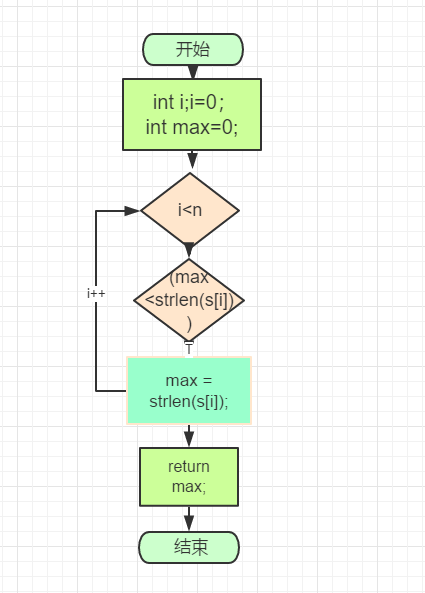
3).本题调试过程碰到问题及解决办法
无错误
4).运行结果截图
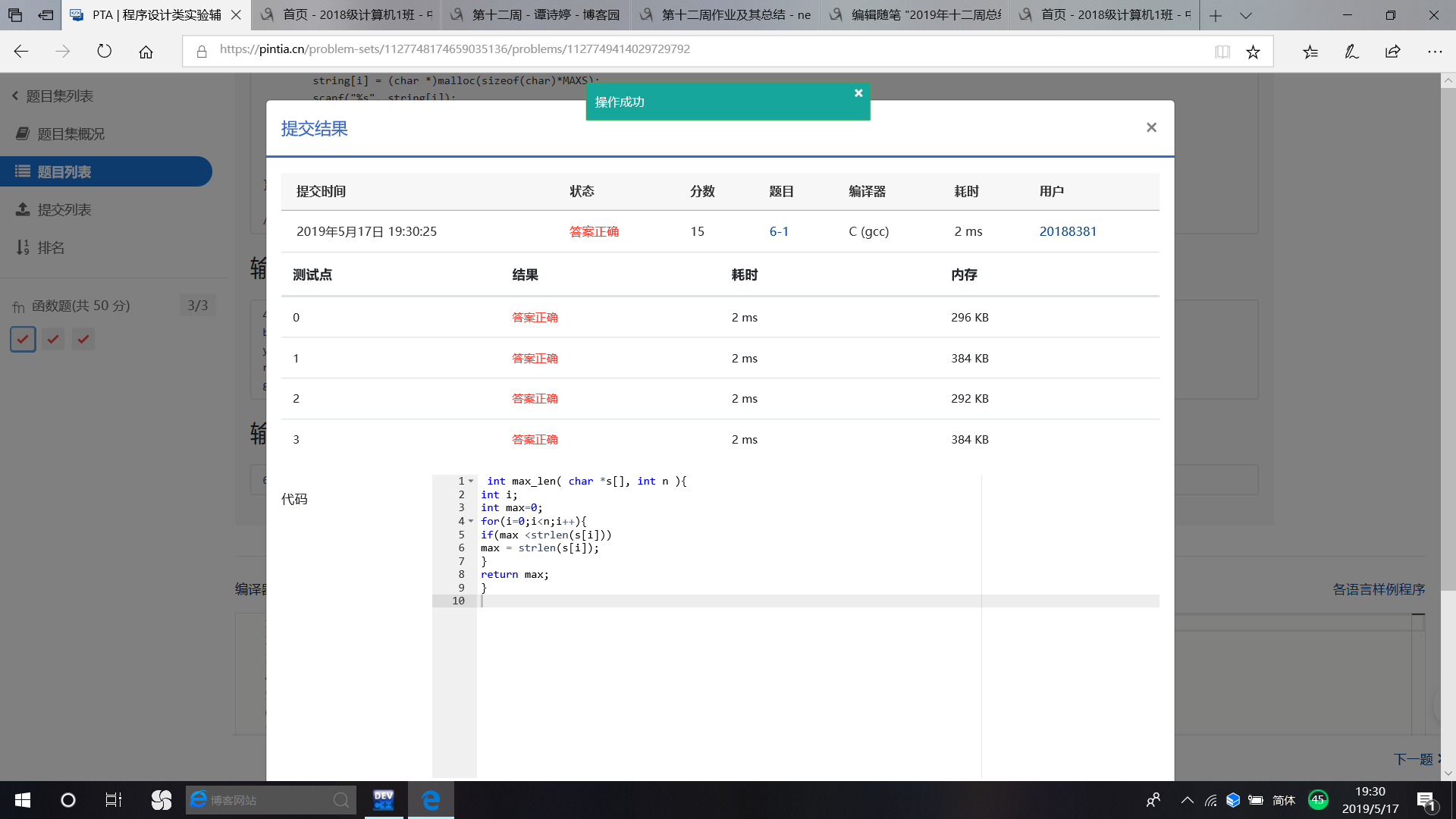
题目6-2 统计专业人数 (15 分)
本题要求实现一个函数,统计学生学号链表中专业为计算机的学生人数。链表结点定义如下:
struct ListNode {
char code[8];
struct ListNode *next;
}
这里学生的学号共7位数字,其中第2、3位是专业编号。计算机专业的编号为02。
函数接口定义:
int countcs( struct ListNode *head );
其中head是用户传入的学生学号链表的头指针;函数countcs统计并返回head链表中专业为计算机的学生人数。
裁判测试程序样例:
#include <stdio.h>
#include <stdlib.h>
#include <string.h>
struct ListNode {
char code[8];
struct ListNode *next;
};
struct ListNode *createlist(); /*裁判实现,细节不表*/
int countcs( struct ListNode *head );
int main()
{
struct ListNode *head;
head = createlist();
printf("%d
", countcs(head));
return 0;
}
/* 你的代码将被嵌在这里 */
输入样例:
1021202
2022310
8102134
1030912
3110203
4021205
#
输出样例:
3
1).实验代码
int countcs(struct ListNode*head)
{
int num=0;
struct ListNode *p=head;
while(p!=NULL){
if (p->code[1]=='0'&&p->code[2]=='2'){
num++;
}
p=p->next;
}
return num;
}
2). 设计思路

3).本题调试过程碰到问题及解决办法
无错误
4).运行结果截图

题目6-3 删除单链表偶数节点 (20 分)
本题要求实现两个函数,分别将读入的数据存储为单链表、将链表中偶数值的结点删除。链表结点定义如下:
struct ListNode {
int data;
struct ListNode *next;
};
函数接口定义:
struct ListNode *createlist();
struct ListNode *deleteeven( struct ListNode *head );
函数createlist从标准输入读入一系列正整数,按照读入顺序建立单链表。当读到−1时表示输入结束,函数应返回指向单链表头结点的指针。
函数deleteeven将单链表head中偶数值的结点删除,返回结果链表的头指针。
裁判测试程序样例:
#include <stdio.h>
#include <stdlib.h>
struct ListNode {
int data;
struct ListNode *next;
};
struct ListNode *createlist();
struct ListNode *deleteeven( struct ListNode *head );
void printlist( struct ListNode *head )
{
struct ListNode *p = head;
while (p) {
printf("%d ", p->data);
p = p->next;
}
printf("
");
}
int main()
{
struct ListNode *head;
head = createlist();
head = deleteeven(head);
printlist(head);
return 0;
}
/* 你的代码将被嵌在这里 */
输入样例:
1 2 2 3 4 5 6 7 -1
输出样例:
1 3 5 7
1).实验代码
return(head);
}
struct ListNode*deleteeven(struct ListNode*head)
{
struct ListNode*p,*q;
if(head==NULL)
{
return NULL;
}
p=head;
q=p->next;
while(q!=NULL)
{
if(q->data%2==0)
{
p->next=q->next;
free(q);
q=p->next;
}
else
{
p=p->next;
q=p->next;
}
}
if(head->data%2==0)
{
head=head->next;
}
return(head);
}
2). 设计思路
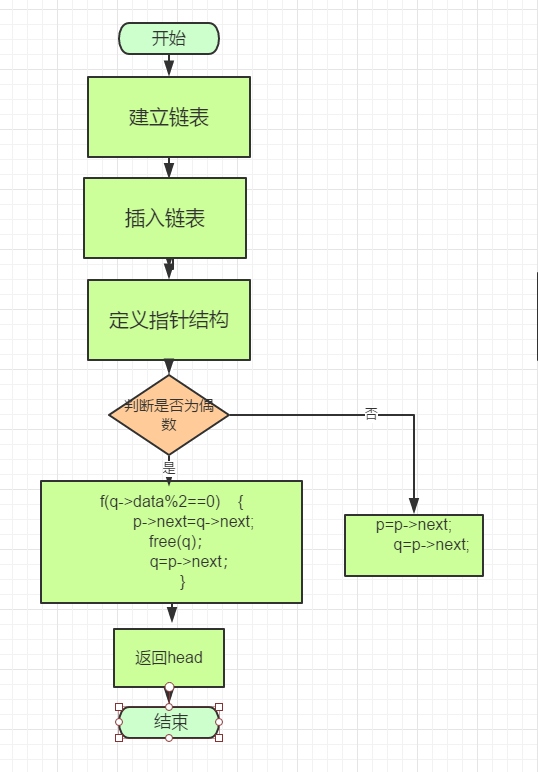
4).运行结果截图
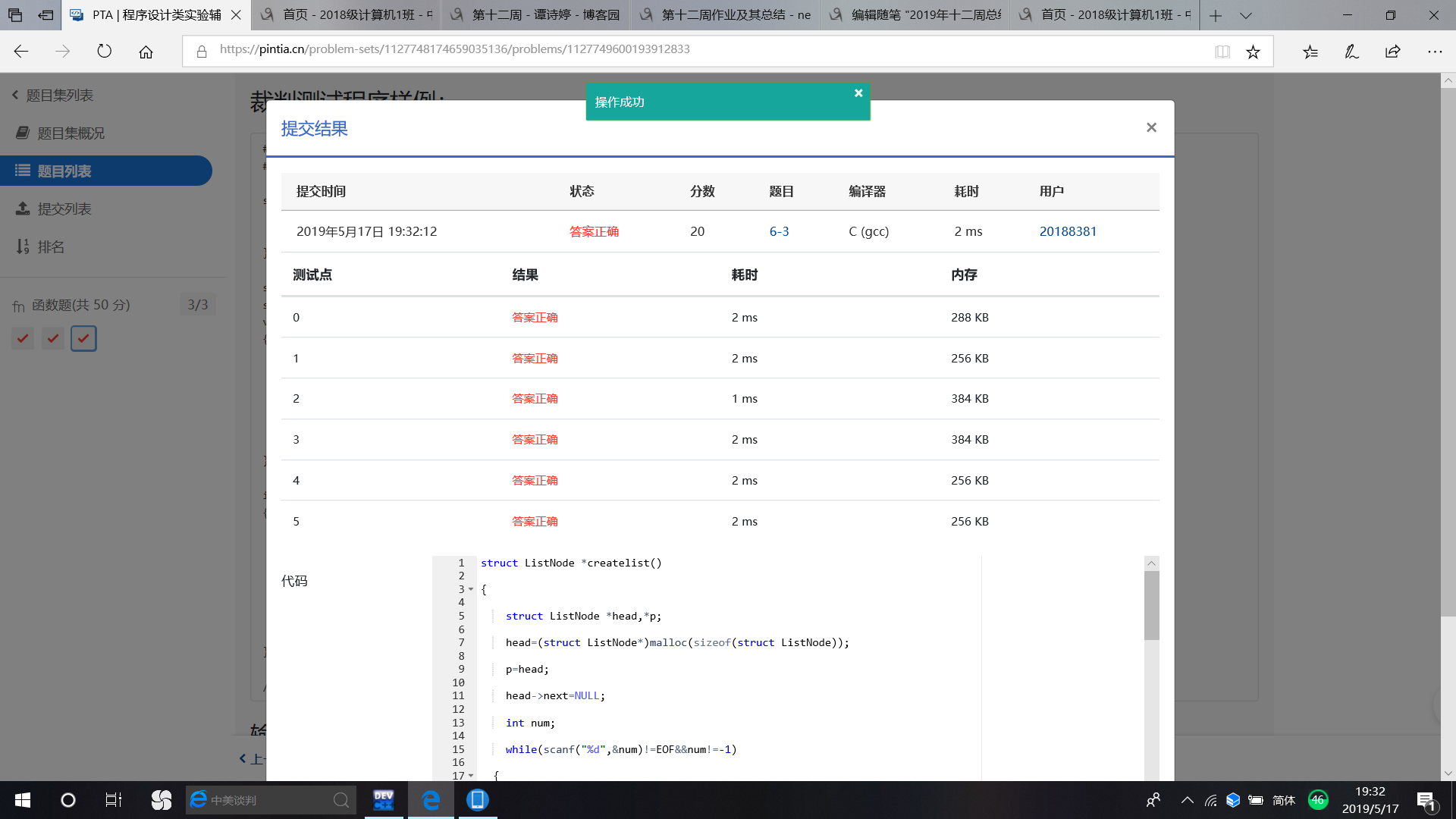
二、学习进度条
| 周/日期 | 这周所花时间 | 代码行数 | 学到的知识点简介 | 目前比较困惑的问题 |
|---|---|---|---|---|
| 3.4/-3.9 | 8小时 | 89行 | 文件的读或写 | 文件中各种函数程序 |
| 3.10/3.15 | 6小时 | 91行 | 多维数组的应用 | 二维数组应用的不灵活 |
| 3.16/3.19 | 8小时 | 92行 | 二维数组求值与鞍点 | 序法的应用 |
| 3.30/4.4 | 7小时 | 69行 | 数组与字符串的用法 | 指针与数组的关系 指针的灵活应用 |
| 4.6/4.12 | 9小时 | 200行 | 指针作为函数参数的应用 | 数组与指针的相互关系 |
| 4.14/4.19 | 6小时 | 212 | 字符串函 | 动态内存分配 |
| 4.21/4.26 | 7小时 | 156 | 结构 | 结构指针 |
| 5.6/5.10 | 7小时 | 103行 | 递归函数,宏定义 | 题不会做 |
| 5.9/5.17 | 6小时 | 201 | 单向链表的操作 | 二级指针 |
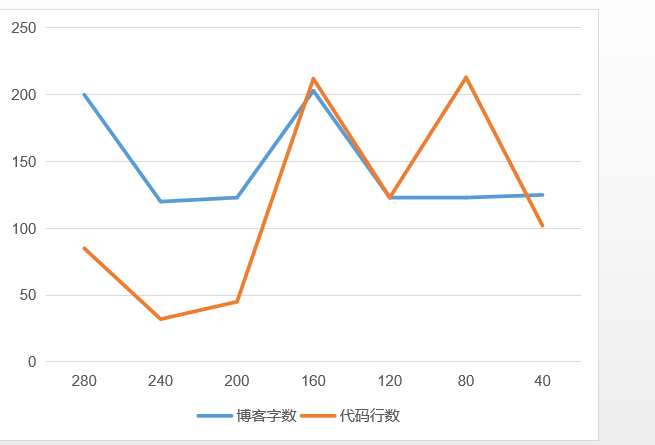 |
三、学习感悟
不多了,要抓紧现在的进度不能落下太多
C语言也快接近尾声了我么也要适当的看看前面的东西了
学习的是结构及其各种用法,总的来说并不是很难
过好现在,别浪费好时光。
四、结对编程
优点:
可以利用各自的优势去弥补劣势,各抒己见,取长补短
缺点:
**
敢跨过障碍,果断切除懒癌
**